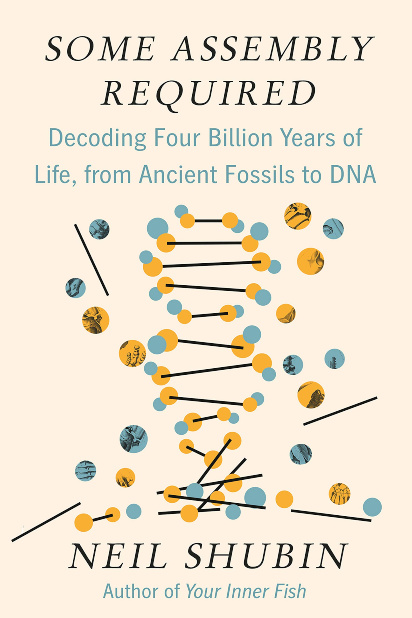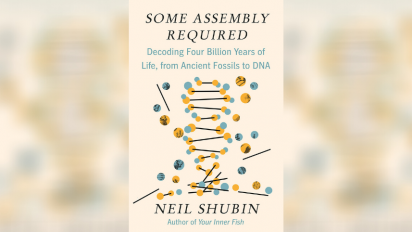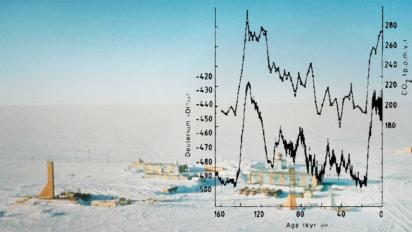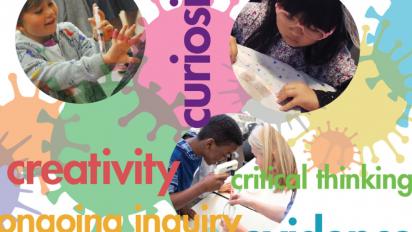In Some Assembly Required, Neil Shubin dons his molecular biologist hat. In Your Inner Fish (2008), written with his paleontologist hat on, Shubin described the discovery and significance of Tiktaalik roseae, a fossil fish with features like those of early tetrapods, unearthed in 2004 in Canada’s High Arctic. This discovery marked a seismic shift in our understanding of how changes in animal bodies were organized as they moved to new modes of life and habitat.
 Now, in his third book, Shubin explains how paleontology and molecular biology are working together to illuminate the history of life. “Rocks and fossils, when coupled with DNA technology, have the power to probe some of the classic questions that Darwin and his contemporaries struggled with,” he explains. “New experiments reveal a multibillion-year history filled with cooperation, repurposing, competition, theft, and war” (p. xi).
Now, in his third book, Shubin explains how paleontology and molecular biology are working together to illuminate the history of life. “Rocks and fossils, when coupled with DNA technology, have the power to probe some of the classic questions that Darwin and his contemporaries struggled with,” he explains. “New experiments reveal a multibillion-year history filled with cooperation, repurposing, competition, theft, and war” (p. xi).
Shubin enthusiastically describes the new vistas on the history of life that the collaboration of paleontology and molecular biology are beginning to provide. But he is no less enthusiastic about telling the stories of the scientific and even personal struggles of the researchers, which go beyond the usual textbook narratives of scientific innovations.
One of my favorite vignettes was Shubin’s discussion of Walter Garstang, a 20th-century zoologist who wrote amusing poetry, studied tadpoles, and combined his interests in a book of jingles, Larval Forms and Other Zoological Verses (1951). From “The Axolotl and the Ammocoete”:
Amblystoma’s a giant newt who rears in swampy waters,
As other newts are wont to do, a lot of fishy daughters:
These axolotls, having gills, pursue a life aquatic,
But, when they should transform to newts, are naughty and erratic.
As Garstang’s poem whimsically explains, in metamorphosis, the larvae of animals such as axolotls and salamanders lose their gills, changing from an aquatic life-style to a terrestrial life-style. “The shift from water to land, something that happened over millions of years in our own fishy past, happens over a few days of metamorphosis in these creatures,” Shubin observes (p. 43).
Garstang was also fascinated by sea squirts, which as free-swimming larvae have a nerve cord, a connective tissue rod from head to tail, and gill slits: three hallmarks of our own vertebrate lineage. These features are lost or drastically modified when sea squirts become sessile adults. Garstang regarded these facts about development as evolutionarily significant: “rich with artifacts of the history of life and potential for its future,” as Shubin puts it (p. 42). The ancestor of all vertebrates might have been a sea-squirt-like animal that retained its nerve cord, connective tissue rod, and gill slits into adulthood thanks to changes in its developmental timing.
Since Garstang’s day, biologists have increasingly devoted attention to exploring whether alterations to the timing of embryonic development could have resulted in new kinds of creatures with different bodies, poised to enter new habitats. But now they are doing so with molecules as well as with morphology. As Shubin observes, the recipe for building animal bodies in each new generation is inscribed in the language of nucleic acids. Discovering the physical structure of DNA allowed biochemists to map the amino acid sequences of different proteins to understand how they work in the body.
Twentieth-century biochemist Emile Zuckerkandl extracted and separated crab hemoglobin proteins, using differences in molecular size and electric charge. Moving to larger game, he found that human and ape hemoglobin molecules shared more amino acids with each other than those of frogs and fish did, indicating that humans and apes are more closely related than fish and frogs are. Zuckerkandl and Linus Pauling realized that proteins are a kind of molecular clock for understanding evolution. Assuming that amino acid substitutions occur at constant rates over long periods of time, the more the proteins of two species differ, the longer they have been evolving independently from a common ancestor.
So fossils are no longer the sine qua non for deciphering the history of life; the molecular clock is now also used to determine the ages of various species. After Zuckerkandl and Pauling, evolutionary history would not be the sole province of paleontologists: biochemists now had a dog, or at least a molecule, in the hunt.
Shubin explains more recent research and discoveries in gene regulation as pioneered by 20th-century biologists François Jacob and Jacques Monod, the investigation of jumping genes by Barbara McClintock, the mapping of the human genome, and most recently, the gene-editing technology of CRISPR-Cas9.
Having begun with a fish swimming onto land, he ends by marveling at an even greater leap: “through eons of jury-rigging, duplicating, and co-opting, single-celled microbes have evolved to the point where their descendants thrive in every habitat on the planet and have even walked on the moon” (p. 217). As Some Assembly Required demonstrates, our endeavor to understand life and nature’s diversity is intimately connected to the research, effort, and thought of our predecessors.





